Written by: Marge Vorndam, Native Plant Master
with information supplied by the Pueblo County Colorado State University Extension Director, Sherie Shaffer
Honeybees are not native to North America but were imported from Europe in the 17th Century. Agriculturalists desired the services that the honeybees in Europe provided to fertilize crops. This includes many fruits such as apples, oranges, cherries and strawberries as well as vegetables such as tomatoes, broccoli, and nuts like pecans and almonds. Among crops fertilized by honeybees are alfalfa, soybeans and other plants grown for hay. There are many other insects that also aid in plant pollination, but honeybees are desired for their own end-crop, honey, that is gathered by the bees into hives during the plant pollination process. Today, honeybees are responsible not only for the fertilization of plants. According to the USGS, “In a single year, one honeybee colony can gather about 40 pounds of pollen and 265 pounds of nectar. Honeybees increase our nation’s crop values each year by more than 15 billion dollars.”
Honeybees both pollinate plants and collect nectar from the flowers. Pollen is a powdery substance containing the male gametes that flowers produce to fertilize the plant’s female ovule. The flower ovule then grows the seeds which spread to produce new plants. Flowers provide the nectar to draw in pollinators like bees to aid in the fertilization process. As we humans attest, the harvested nectar is full of sugar carbohydrates, which creates a market for nectar.
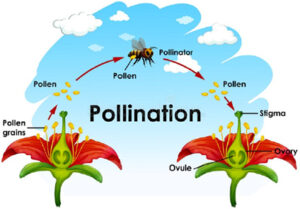
Honeybees carry nectar and pollen to hives. Generally, the hives are provided to farmers from Apiaries which are owned by Beekeepers. The Beekeepers will rent the hives where the honey and pollen are stored to raise the young bees of the next generation. The result is that crops are fertilized, and the Beekeeper can gather and sell the honey from each hive.
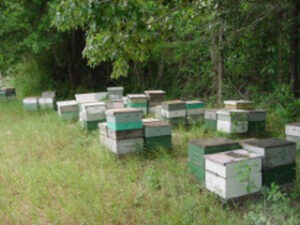
Image of bee hives from https://en.wikipedia.org/wiki/Apiary#/media/File:Apiary_259F.JPG
This photo shows the inside of each hive with the cells where the bees deposit the honey and pollen. The eggs are laid within each cell which is then sealed with bee wax. This entire structure which is created by the bees is called the honeycomb.
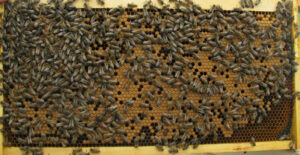
Each individual swarm of bees form a bee colony (one per hive). It has only one fertile female bee. This bee is referred to as the Queen bee. She produces the eggs that are laid in the hive. There are also drone bees whose sole purpose is to mate with the Queen. All other bees are worker bees who make the honeycomb, gather the honey and pollen and care for the hive.
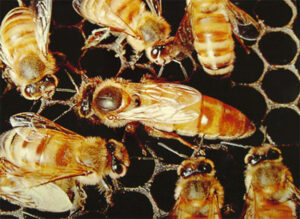
photo above from From Grow Organic. 2023. Meet the 3 kinds of honey bees in a hive. https://www.groworganic.com/blogs/articles/meet-the-three-kinds-of-honey-bees-in-a-bee-hive
For many reasons, Queen bees will leave the hive with many workers to begin a new hive. You may have seen a moving colony such as this one:
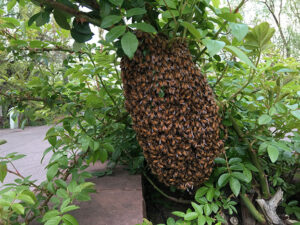
Photo above from BackYardHive, 2023. Colorado Bee Swarm Hotline. https://backyardhive.com/pages/bee-swarm-removal-hotline
Bee swarms mainly occur in April and May. If you see a swarm, contact the Pueblo County Extension Office at 719 583-6566 for names of Apiarists who will collect the traveling hive for relocation.
Unfortunately, honeybee colonies have been diminished by development, climate change, the use of pesticides and spreading bee colony-destroying diseases. Losses of colonies have run over 50% in recent years in our nation. This causes issues with crop and honey production. Foulbrood is one such disease which kills young developing bees. Recently, the USDA released a new vaccine to eliminate that disease from affected hives.
What can you do to help perpetuate the helpful honeybee in your landscape?
Consider taking the following actions:
1. Grow native flowers that especially benefit bees – a few are
Nodding Onion (Allium cernuum)
Giant Hyssop (Agastache foeniculum)
Chocolate Flower (Berlandiera lyrata)
Rocky Mountain Bee Plant (Cleome serrulata)
Rabbitbrush (Ericameria nausseosa)
Blanketflower (Gaillardia aristate)
Catnip (Nepeta cataria)
Wild Buckwheat (Eriogonum jamseii)
Early Spring Senecio (Senecio integerrimus)
Goldenrod (Solidago mollis)
Pasque Flower (Anemone patens var. multifida)
Sulfur Flower (Eriogonum umbellatum)
Rocky Mountain Penstemon (Penstomen strictus)
Black Eyed Susan (Rudbeckia hirta)
Tansy Aster (Machaeranthera canescens)
Golden Currant (Ribes aureum)
Woods Rose (Rosa woodsia)
Purple Berkheya (Berkheya purpurea)
Fernbush (Chamaebatiaria millefolium)
Iceplant (Sedum spectabile)
Compass plant (Silphium laciniatum)
Royal candles (Veronica spicata)
2. Maintain Prairie Hedgerow Strips
3. Keep use of herbicides and pesticides to a minimum. Honeybees can carry these chemicals back to the hive where it damages the lifecycle there.
As we see, honeybees are critical to maintain the amount of food that our nation requires. Please join us by doing your part to help preserve this important resource.
Shaffer, S. 2023. Gardening for honeybees. Pueblo County Colorado State University Extension, Pueblo, CO.
Bee Informed Team, 2022. United States Honey Bee Colony Losses 2021-2022.
USGS. 2023. Are honeybees native to North America? https://www.usgs.gov/faqs/are-honey-bees-native-north-america


